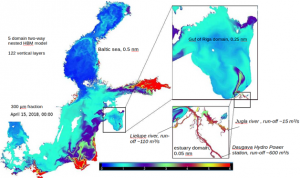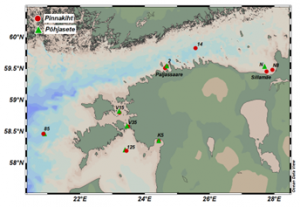BOOS Marine plastic WG is a network of 8 institutes in Baltic Sea countries which actively carry out marine micro- and macroplastic monitoring, analysis, modelling and research. The WG objective is to i) share marine plastic data, knowledge, technology, research outcomes and best practices; ii) Co-ordinate, harmonize and develop marine plastic related observation, information, forecasting systems and services for the Baltic Sea through effective cooperation; iii) develop joint publications and joint proposals.

Figure 1. A high resolution micropalstic modelling tool resolving the inland water-estuarial-coastal-open sea transport in the Baltic Sea. Color map represents modeled surface concentration of 300 µm MP particles at 2018.04.15 showing Daugava river plume after a spring flood (Frishfelds et al., 2022).
Seamless two-way nesting modelling tool developed by DMI for simulating microplastic transport using an Eulerian approach, with capacity to resolving inland water pathways and processes of current-/wave-induced transport, biofouling, sedimentation (Fig. 1). Lagrangian modelling of marine plastics have been developed in TalTech. Regular monitoring cruises on microplastics in national EEZ waters and sediments have been carried out in Estonia, Finland, Latvia, Lithuania and Poland. Automatic microplastic sampler has been developed, tested in the field and optimized by TalTech in JPI-Ocean Project RESPONSE. In addition, microplastic concentration have been observed in different research projects. In a recent study in total 27 microplastic datasets have been collected (She et al., 2022).


Figure 2. Left: automatic microplastic sampler developed in EU project CLAIM and RESPONSE; right: micropalstic monitoring stations in Estonia EEZ. Red: routine monitoring cruises, green: stations measured in EU project CLAIM.
For more details:
- 2021 MPWG Workshop minutes
- 2020/21 MPWG Annual report
- 2021 MPWG activity summary
- 2023 MPWG activity summary
- Member presentations & publications











